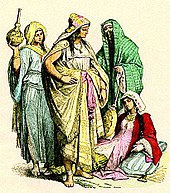Islamic law is the product of Qur'anic guidelines, as understood by Islamic jurisprudence (fiqh), as well as of the interpretations derived from the traditions of Prophet Muhammad (hadith), that were agreed upon by majority of Muslim scholars as authentic beyond doubt based on the Science of Hadith[2][7] These interpretations and their application were shaped by the historical context of the Muslim world at the time they were written.[2] Many of the earliest writings were from a time of tribal warfare which could have been inappropriate for the 21st Century.
The Marxist writer, Valentine M. Moghadam argues that the position of women are mostly influenced by the extent of urbanization, industrialization, proletarization and political ploys of the state managers rather than culture or intrinsic properties of Islam; Islam, per Moghadam, is neither more nor less patriarchal than other world religions especially Hinduism, Christianity and Judaism.[8][9]

"The dowry, previously regarded as a bride-price paid to the father, became a nuptial gift retained by the wife as part of her personal property."[10][11]
Under Islamic law, marriage was no longer viewed as a "status" but rather as a "contract", in which the woman's consent was imperative.[10][11][12] "Women were given inheritance rights in a patriarchal society that had previously restricted inheritance to male relatives."[10] Annemarie Schimmel states that "compared to the pre-Islamic position of women, Islamic legislation meant an enormous progress; the woman has the right, at least according to the letter of the law, to administer the wealth she has brought into the family or has earned by her own work."[13]
William Montgomery Watt states that Muhammad, in the historical context of his time, can be seen as a figure who promoted women’s rights and improved things considerably. Watt explains: "At the time Islam began, the conditions of women were terrible - they had no right to own property, were supposed to be the property of the man, and if the man died everything went to his sons." Muhammad, however, by "instituting rights of property ownership, inheritance, education and divorce, gave women certain basic safeguards."[14]
During his life, Muhammad married eleven women depending upon the differing accounts of who were his wives. His last wife, Aisha was six or seven years old when she was married, though at the time women married at an early age. Muhammad saw in her a great woman of the future who was best suited to perform the duties of a wife and of a teacher, whose words and deeds had to be preserved for the guidance of mankind.[15][16][17][18] Aisha was nine years old when Muhammad consummated the marriage.[19][20][21][22][23][24][25] Aisha's age at the time of her marriage consummation has been a subject of criticism and controversy. Many Shiite scholars[who?] dispute Aisha was six or seven when Muhammad married her. They contend that she was between thirteen and sixteen when he married her. Furthermore, they believe Muhammad's most favored wife was his first wife, Khadija. He married her while he was in Mecca, but she died before he migrated to Medina. Muhammad called the year of Khadija's death the "Year of Sorrow." When Muhammad settled in Medina and married several wives, he would often mention Khadija and her contributions to Islam. Some of Muhammad's wives would be uncomfortable when he mentioned Khadija. The Prophet was once disappointed with Aisha because she complained when he mentioned Khadija.


No comments:
Post a Comment